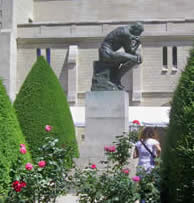Lynda Slimmer
 |
Above: Rodin’s Thinker, Rodin Museum, Paris. Left: Group in front of Rodin’s Burghers of Calais, Rodin Museum, Paris. |
I am not an especially creative person. I am a doer; I get things done. I help others channel their creativity into realistic outcomes. However, I am that individual that theologian and ethicist, Richard Niebuhr describes as “a poet who creates by taking journeys.” My creative self is most stimulated when a trip challenges me to step outside my comfort zone and stretch my perception of who I am. The Art and Healing Pilgrimage to France this summer, sponsored by the Nurses & Humanities Program of the Hektoen Institute of Medicine in Chicago, offered me such an opportunity.
Why this excursion to France? I do not speak French and the arts are not typically where I go to for inspiration and solace. But as Phil Cousineau notes in his book The Art of Pilgrimage: The Seeker’s Guide to Making Travel Sacred, the journey “is the art of re-imagining how we walk, talk, listen, see, hear, write and draw…What is missing longs to be filled in.” This pilgrimage to France inspired me to “re-image” my relationship with the arts. I experienced how the arts were able to not only lift and restore my own spirit, but also enrich the care I provide as a professional nurse.
On a beautiful summer morning in Paris, I engaged in a sketching class on the lawn of the Musée Rodin. Using the artist’s focusing square, I sighted a small stone ornament on a building in the distance and clumsil

Walking has always been therapeutic for me. Retracing the steps of Vincent Van Gogh in the village of Auvers-sur-Oise from his small dimly lit room to the open fields where he painted, and arriving at his cemetery resting place was like, as Cousineau says, “taking my soul for a stroll.” When standing in Van Gogh’s room, I came to recognize more than ever before that life’s experiences and one’s responses can be the source of both great creative beauty and great mental anguish. We may not be able to control what we encounter in life, but with support from others we can take command of our responses to those experiences. Unfortunately, Van Gogh did not always have the assistance he needed and his mental anguish resulted in his death. As a mental health nurse, I will always remember that my patients, like Van Gogh, have so much life potential if provided with understanding and encouragement.
Prior to my pilgrimage, I was very much a novice in terms of understanding and even appreciating both the aesthetic and historical value of the visual arts. However, one cannot experience the galleries of the Musée d’Orsay, Musée de l’Orangerie, and Musée du Louvre without truly encountering the magnitude of the impact of the arts. For instance, viewing the works of the impressionists at Musée d’ Orsay re-awakened in me the importance of perspective. It is not so much the reality of what each of us sees, but how we interpret what we see that is of value to us, that influences us. Artists’ paintings are their interpretations of reality as seen from their perspective. I need to remember this when I care for patients. Patients’ interpretations of their illness, their symptoms, and their feelings are their reality as they perceive it. I need to view their “picture” and not paint my own.
As the airplane raced down the runway toward take off from Paris, I was reminded of Cousineau’s admonition to “remember again and again that the true pilgrimage is into the undiscovered land of your own imagination, which you could not have explored any other way than through these lands, with gratitude in your satchel and the compassion for all you see as your touchstone.” On this pilgrimage I discovered the art of re-imagining and I will be forever grateful for the renewed sense of compassion endowed to me by the arts.
, RN, PhD, is an Associate Dept. Head for the Department of Biobehavioral Health Science, at the University of Illinois at Chicago, College of Nursing.
Highlighted in Frontispiece Winter 2009- Volume 1, Issue 2
Winter 2009 | Sections | Travel


Leave a Reply